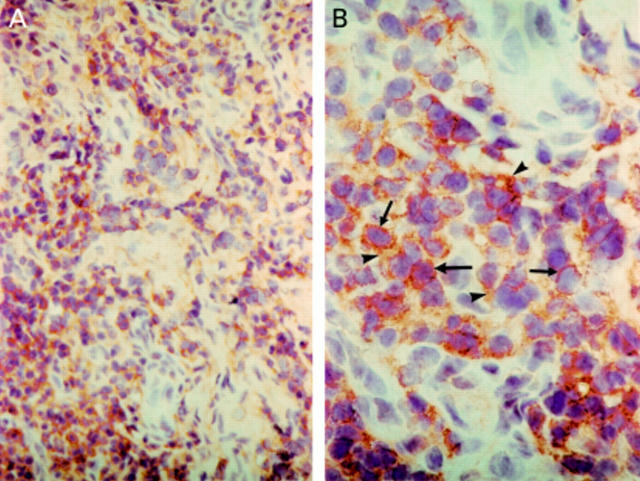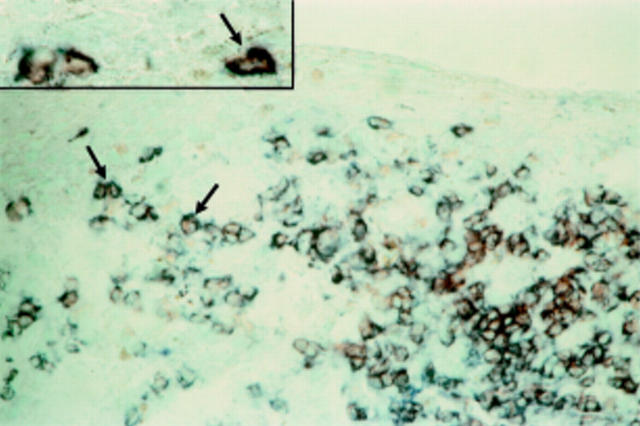Abstract
BACKGROUND/AIMS—Chemokines are small peptides which are potent activators and chemoattractants for leucocyte subpopulations. Their action is mediated by a family of seven transmembrane spanning G-protein coupled receptors. The aims of this study were to examine the expression of the chemokine receptors CCR1, CCR3, CCR5, CXCR3, and CXCR4 in the conjunctiva of patients with vernal keratoconjunctivitis (VKC) and to investigate the phenotype of inflammatory cells expressing these chemokine receptors. METHODS—Conjunctival biopsy specimens from 16 patients with active VKC, and eight control subjects were studied by immunohistochemical techniques using a panel of monoclonal antibodies directed against human CCR1, CCR3, CCR5, CXCR3, and CXCR4. The phenotype of inflammatory cells expressing chemokine receptors was examined by double immunohistochemistry. RESULTS—In the normal conjunctiva, few inflammatory cells expressed CXCR3 in five of eight specimens. There was no immunoreactivity for CCR1, CCR3, CCR5, and CXCR4. In VKC specimens, membranous immunoreactivity for CXCR3 was noted on inflammatory cells in all specimens. Compared with control specimens, VKC specimens showed significantly more inflammatory cells expressing CXCR3 (54.3 (SD 34.3) v 3.3 (5.0); p<0.001). Few CCR1+, CCR3+, CCR5+, and CXCR4+ inflammatory cells were observed in only three of 16 specimens. Double immunohistochemistry revealed that all CXCR3 positive inflammatory cells were CD3 positive T lymphocytes and that 61.7% (3.7%) of the infiltrating T lymphocytes were reactive for CXCR3. CONCLUSIONS—CXCR3 is the predominant chemokine receptor and is expressed abundantly on T lymphocytes in the conjunctiva of patients with active VKC. These data suggest a potential role for CXCR3 receptors in the regulation of lymphocyte recruitment within conjunctiva of VKC patients. New therapeutic strategies that block CXCR3 may inhibit T lymphocyte recruitment and suppress adverse inflammatory reactions.
Full Text
The Full Text of this article is available as a PDF (177.3 KB).
Figure 1 .
Vernal keratoconjunctivitis. Immunohistochemical staining for CXCR3. Low power (A) (×500) and high power (B) (×1200) views showing membranous immunoreactivity on mononuclear cells (arrows), as well as in the intercellular spaces (arrowheads).
Figure 2 .
Vernal keratoconjunctivitis. Double immunohistochemistry for CXCR3 (red), and CD3 (blue). Low power (×500) and high power (×1200) (inset) views showing CXCR3 positive cells coexpressing CD3 marker (arrows).
Selected References
These references are in PubMed. This may not be the complete list of references from this article.
- Abu El-Asrar A. M., Struyf S., Al-Kharashi S. A., Missotten L., Van Damme J., Geboes K. Chemokines in the limbal form of vernal keratoconjunctivitis. Br J Ophthalmol. 2000 Dec;84(12):1360–1366. doi: 10.1136/bjo.84.12.1360. [DOI] [PMC free article] [PubMed] [Google Scholar]
- Abu el-Asrar A. M., Geboes K., al-Kharashi S., Tabbara K. F., Missotten L., Desmet V. Adhesion molecules in vernal keratoconjunctivitis. Br J Ophthalmol. 1997 Dec;81(12):1099–1106. doi: 10.1136/bjo.81.12.1099. [DOI] [PMC free article] [PubMed] [Google Scholar]
- Agace W. W., Roberts A. I., Wu L., Greineder C., Ebert E. C., Parker C. M. Human intestinal lamina propria and intraepithelial lymphocytes express receptors specific for chemokines induced by inflammation. Eur J Immunol. 2000 Mar;30(3):819–826. doi: 10.1002/1521-4141(200003)30:3<819::AID-IMMU819>3.0.CO;2-Y. [DOI] [PubMed] [Google Scholar]
- Albanesi C., Scarponi C., Sebastiani S., Cavani A., Federici M., De Pità O., Puddu P., Girolomoni G. IL-4 enhances keratinocyte expression of CXCR3 agonistic chemokines. J Immunol. 2000 Aug 1;165(3):1395–1402. doi: 10.4049/jimmunol.165.3.1395. [DOI] [PubMed] [Google Scholar]
- Allansmith M. R., Ross R. N. Ocular allergy. Clin Allergy. 1988 Jan;18(1):1–13. doi: 10.1111/j.1365-2222.1988.tb02837.x. [DOI] [PubMed] [Google Scholar]
- Annunziato F., Cosmi L., Galli G., Beltrame C., Romagnani P., Manetti R., Romagnani S., Maggi E. Assessment of chemokine receptor expression by human Th1 and Th2 cells in vitro and in vivo. J Leukoc Biol. 1999 May;65(5):691–699. doi: 10.1002/jlb.65.5.691. [DOI] [PubMed] [Google Scholar]
- Bonecchi R., Bianchi G., Bordignon P. P., D'Ambrosio D., Lang R., Borsatti A., Sozzani S., Allavena P., Gray P. A., Mantovani A. Differential expression of chemokine receptors and chemotactic responsiveness of type 1 T helper cells (Th1s) and Th2s. J Exp Med. 1998 Jan 5;187(1):129–134. doi: 10.1084/jem.187.1.129. [DOI] [PMC free article] [PubMed] [Google Scholar]
- Calder V. L., Jolly G., Hingorani M., Adamson P., Leonardi A., Secchi A. G., Buckley R. J., Lightman S. Cytokine production and mRNA expression by conjunctival T-cell lines in chronic allergic eye disease. Clin Exp Allergy. 1999 Sep;29(9):1214–1222. doi: 10.1046/j.1365-2222.1999.00585.x. [DOI] [PubMed] [Google Scholar]
- Cole K. E., Strick C. A., Paradis T. J., Ogborne K. T., Loetscher M., Gladue R. P., Lin W., Boyd J. G., Moser B., Wood D. E. Interferon-inducible T cell alpha chemoattractant (I-TAC): a novel non-ELR CXC chemokine with potent activity on activated T cells through selective high affinity binding to CXCR3. J Exp Med. 1998 Jun 15;187(12):2009–2021. doi: 10.1084/jem.187.12.2009. [DOI] [PMC free article] [PubMed] [Google Scholar]
- Daugherty B. L., Siciliano S. J., DeMartino J. A., Malkowitz L., Sirotina A., Springer M. S. Cloning, expression, and characterization of the human eosinophil eotaxin receptor. J Exp Med. 1996 May 1;183(5):2349–2354. doi: 10.1084/jem.183.5.2349. [DOI] [PMC free article] [PubMed] [Google Scholar]
- Flier J., Boorsma D. M., Bruynzeel D. P., Van Beek P. J., Stoof T. J., Scheper R. J., Willemze R., Tensen C. P. The CXCR3 activating chemokines IP-10, Mig, and IP-9 are expressed in allergic but not in irritant patch test reactions. J Invest Dermatol. 1999 Oct;113(4):574–578. doi: 10.1046/j.1523-1747.1999.00730.x. [DOI] [PubMed] [Google Scholar]
- Heath H., Qin S., Rao P., Wu L., LaRosa G., Kassam N., Ponath P. D., Mackay C. R. Chemokine receptor usage by human eosinophils. The importance of CCR3 demonstrated using an antagonistic monoclonal antibody. J Clin Invest. 1997 Jan 15;99(2):178–184. doi: 10.1172/JCI119145. [DOI] [PMC free article] [PubMed] [Google Scholar]
- Jinquan T., Quan S., Jacobi H. H., Jing C., Millner A., Jensen B., Madsen H. O., Ryder L. P., Svejgaard A., Malling H. J. CXC chemokine receptor 3 expression on CD34(+) hematopoietic progenitors from human cord blood induced by granulocyte-macrophage colony-stimulating factor: chemotaxis and adhesion induced by its ligands, interferon gamma-inducible protein 10 and monokine induced by interferon gamma. Blood. 2000 Aug 15;96(4):1230–1238. [PubMed] [Google Scholar]
- Leonardi A., DeFranchis G., Zancanaro F., Crivellari G., De Paoli M., Plebani M., Secchi A. G. Identification of local Th2 and Th0 lymphocytes in vernal conjunctivitis by cytokine flow cytometry. Invest Ophthalmol Vis Sci. 1999 Nov;40(12):3036–3040. [PubMed] [Google Scholar]
- Loetscher M., Gerber B., Loetscher P., Jones S. A., Piali L., Clark-Lewis I., Baggiolini M., Moser B. Chemokine receptor specific for IP10 and mig: structure, function, and expression in activated T-lymphocytes. J Exp Med. 1996 Sep 1;184(3):963–969. doi: 10.1084/jem.184.3.963. [DOI] [PMC free article] [PubMed] [Google Scholar]
- Loetscher M., Loetscher P., Brass N., Meese E., Moser B. Lymphocyte-specific chemokine receptor CXCR3: regulation, chemokine binding and gene localization. Eur J Immunol. 1998 Nov;28(11):3696–3705. doi: 10.1002/(SICI)1521-4141(199811)28:11<3696::AID-IMMU3696>3.0.CO;2-W. [DOI] [PubMed] [Google Scholar]
- Mach F., Sauty A., Iarossi A. S., Sukhova G. K., Neote K., Libby P., Luster A. D. Differential expression of three T lymphocyte-activating CXC chemokines by human atheroma-associated cells. J Clin Invest. 1999 Oct;104(8):1041–1050. doi: 10.1172/JCI6993. [DOI] [PMC free article] [PubMed] [Google Scholar]
- Maggi E., Biswas P., Del Prete G., Parronchi P., Macchia D., Simonelli C., Emmi L., De Carli M., Tiri A., Ricci M. Accumulation of Th-2-like helper T cells in the conjunctiva of patients with vernal conjunctivitis. J Immunol. 1991 Feb 15;146(4):1169–1174. [PubMed] [Google Scholar]
- Montan P. G., Biberfeld P. J., Scheynius A. IgE, IgE receptors, and other immunocytochemical markers in atopic and nonatopic patients with vernal keratoconjunctivitis. Ophthalmology. 1995 May;102(5):725–732. doi: 10.1016/s0161-6420(95)30962-1. [DOI] [PubMed] [Google Scholar]
- Mosmann T. R., Coffman R. L. TH1 and TH2 cells: different patterns of lymphokine secretion lead to different functional properties. Annu Rev Immunol. 1989;7:145–173. doi: 10.1146/annurev.iy.07.040189.001045. [DOI] [PubMed] [Google Scholar]
- Murphy P. M., Baggiolini M., Charo I. F., Hébert C. A., Horuk R., Matsushima K., Miller L. H., Oppenheim J. J., Power C. A. International union of pharmacology. XXII. Nomenclature for chemokine receptors. Pharmacol Rev. 2000 Mar;52(1):145–176. [PubMed] [Google Scholar]
- Ponath P. D., Qin S., Post T. W., Wang J., Wu L., Gerard N. P., Newman W., Gerard C., Mackay C. R. Molecular cloning and characterization of a human eotaxin receptor expressed selectively on eosinophils. J Exp Med. 1996 Jun 1;183(6):2437–2448. doi: 10.1084/jem.183.6.2437. [DOI] [PMC free article] [PubMed] [Google Scholar]
- Qin S., Rottman J. B., Myers P., Kassam N., Weinblatt M., Loetscher M., Koch A. E., Moser B., Mackay C. R. The chemokine receptors CXCR3 and CCR5 mark subsets of T cells associated with certain inflammatory reactions. J Clin Invest. 1998 Feb 15;101(4):746–754. doi: 10.1172/JCI1422. [DOI] [PMC free article] [PubMed] [Google Scholar]
- Rabin R. L., Park M. K., Liao F., Swofford R., Stephany D., Farber J. M. Chemokine receptor responses on T cells are achieved through regulation of both receptor expression and signaling. J Immunol. 1999 Apr 1;162(7):3840–3850. [PubMed] [Google Scholar]
- Sallusto F., Lenig D., Mackay C. R., Lanzavecchia A. Flexible programs of chemokine receptor expression on human polarized T helper 1 and 2 lymphocytes. J Exp Med. 1998 Mar 16;187(6):875–883. doi: 10.1084/jem.187.6.875. [DOI] [PMC free article] [PubMed] [Google Scholar]
- Sallusto F., Mackay C. R., Lanzavecchia A. Selective expression of the eotaxin receptor CCR3 by human T helper 2 cells. Science. 1997 Sep 26;277(5334):2005–2007. doi: 10.1126/science.277.5334.2005. [DOI] [PubMed] [Google Scholar]
- Soto H., Wang W., Strieter R. M., Copeland N. G., Gilbert D. J., Jenkins N. A., Hedrick J., Zlotnik A. The CC chemokine 6Ckine binds the CXC chemokine receptor CXCR3. Proc Natl Acad Sci U S A. 1998 Jul 7;95(14):8205–8210. doi: 10.1073/pnas.95.14.8205. [DOI] [PMC free article] [PubMed] [Google Scholar]
- Sørensen T. L., Tani M., Jensen J., Pierce V., Lucchinetti C., Folcik V. A., Qin S., Rottman J., Sellebjerg F., Strieter R. M. Expression of specific chemokines and chemokine receptors in the central nervous system of multiple sclerosis patients. J Clin Invest. 1999 Mar;103(6):807–815. doi: 10.1172/JCI5150. [DOI] [PMC free article] [PubMed] [Google Scholar]
- Uchio E., Ono S. Y., Ikezawa Z., Ohno S. Tear levels of interferon-gamma, interleukin (IL) -2, IL-4 and IL-5 in patients with vernal keratoconjunctivitis, atopic keratoconjunctivitis and allergic conjunctivitis. Clin Exp Allergy. 2000 Jan;30(1):103–109. doi: 10.1046/j.1365-2222.2000.00699.x. [DOI] [PubMed] [Google Scholar]
- Uguccioni M., Mackay C. R., Ochensberger B., Loetscher P., Rhis S., LaRosa G. J., Rao P., Ponath P. D., Baggiolini M., Dahinden C. A. High expression of the chemokine receptor CCR3 in human blood basophils. Role in activation by eotaxin, MCP-4, and other chemokines. J Clin Invest. 1997 Sep 1;100(5):1137–1143. doi: 10.1172/JCI119624. [DOI] [PMC free article] [PubMed] [Google Scholar]
- Zimmermann N., Conkright J. J., Rothenberg M. E. CC chemokine receptor-3 undergoes prolonged ligand-induced internalization. J Biol Chem. 1999 Apr 30;274(18):12611–12618. doi: 10.1074/jbc.274.18.12611. [DOI] [PubMed] [Google Scholar]
- el-Asrar A. M., Tabbara K. F., Geboes K., Missotten L., Desmet V. An immunohistochemical study of topical cyclosporine in vernal keratoconjunctivitis. Am J Ophthalmol. 1996 Feb;121(2):156–161. doi: 10.1016/s0002-9394(14)70579-3. [DOI] [PubMed] [Google Scholar]




